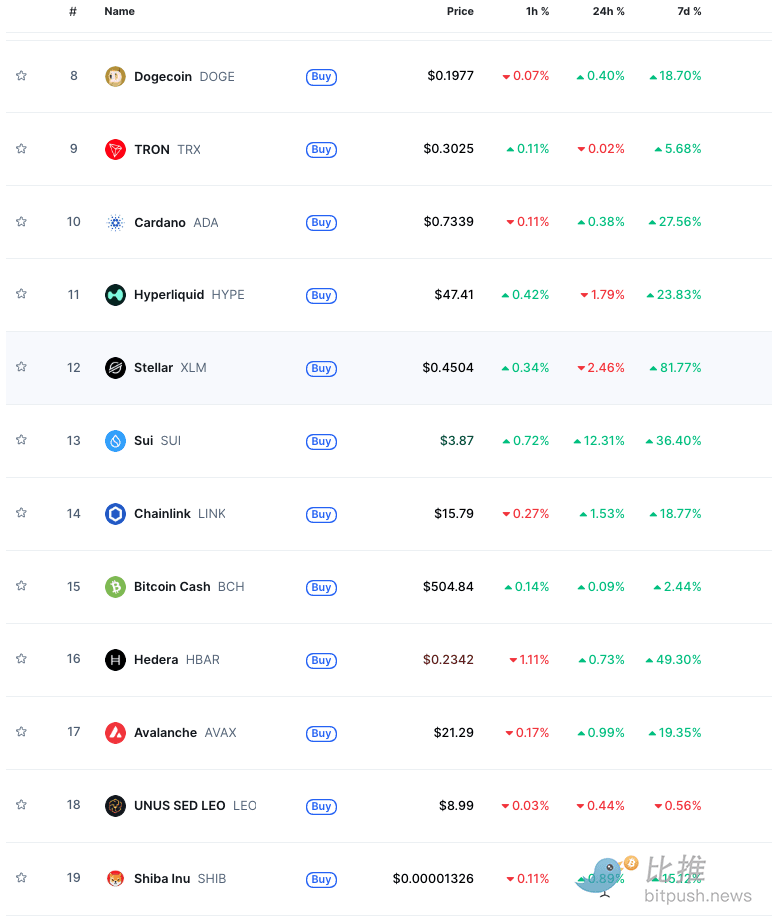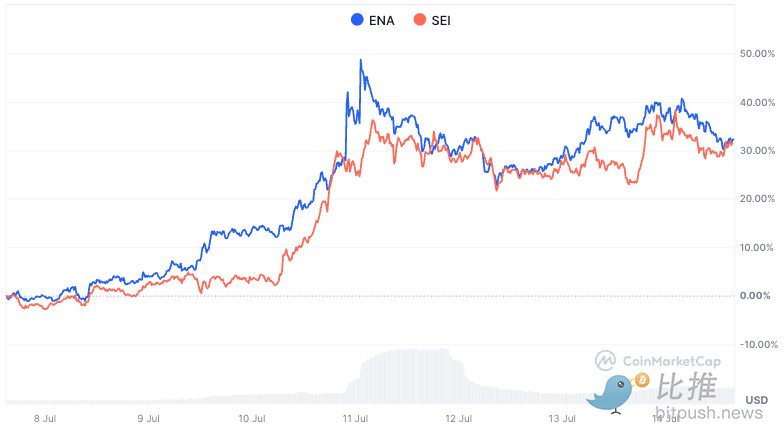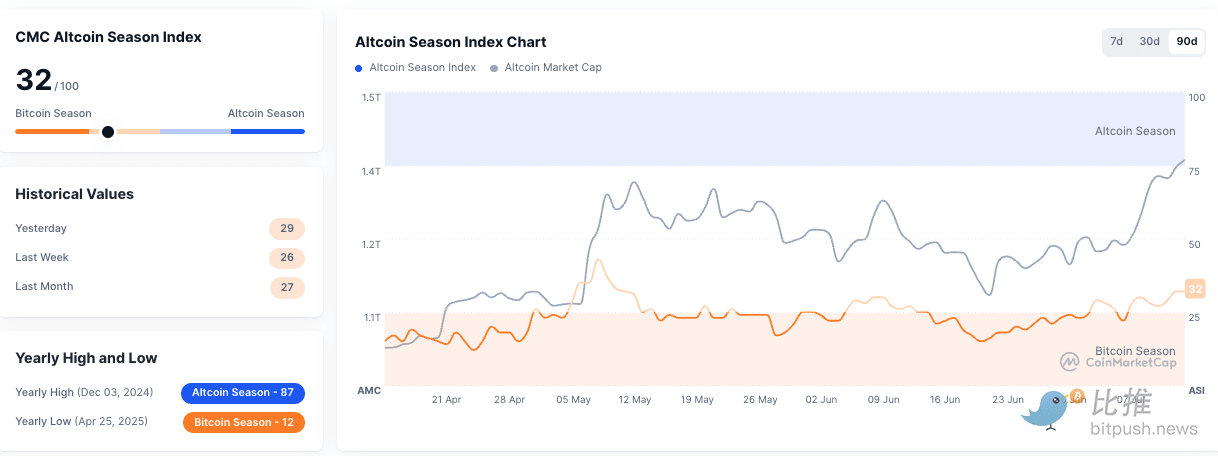Written by: BitpushNews
Recently, Bitcoin (BTC) has repeatedly set new historical highs, briefly surpassing $123,000 per coin. Against the backdrop of Bitcoin's strong upward movement, significant capital rotation is occurring within the crypto market, with a batch of previously relatively dormant major altcoins gradually becoming active, their gains even surpassing those of Bitcoin in recent times.

CMC market data shows that among the top 20 cryptocurrencies by market capitalization, some 'legacy' Layer 1 altcoins have performed prominently, with 7-day increases generally reaching double digits. The leader is Stellar (XLM): ranked 12th among cryptocurrencies, it achieved a weekly increase of 82%, leading its peers. ADA, ranked 10th, saw a 7-day increase of nearly 30%; Ripple (XRP) 29%; Dogecoin (DOGE) 18%.
Some relatively newer altcoins, such as the L1 project Sei (SEI), which focuses on decentralized exchanges (DEX), and the synthetic dollar protocol Ethena (ENA), have also performed well, with a 7-day increase exceeding 30%.

A recent research report by Delphi Digital pointed out that established tokens with a long history that have experienced multiple bull and bear cycles have outperformed the much-hyped AI and DePIN (Decentralized Physical Infrastructure Network) concept tokens since January of this year.
Analysts point out that the collective strength of established altcoins is interpreted as an early signal of retail funds possibly flowing back. These tokens represent long-standing and large-cap cryptocurrencies in the crypto market, and their activity often reflects retail market participation and funding preferences, while traders also keep an eye on emerging projects with innovative narratives and high growth potential.
The 'BANANA ZONE 2.0' of altcoins
Market observers @MerlijnTrader monitored the TOTAL3 chart, which tracks the total market capitalization of cryptocurrencies excluding Bitcoin (BTC) and Ethereum (ETH), effectively reflecting the overall momentum of altcoins. He pointed out that the TOTAL3 chart is entering 'Banana Zone 2.0', which typically indicates that after a period of consolidation, the market is poised for an explosive breakout.
This trader believes that compared to the altcoin wave of 2020, the upcoming market will be 'larger, faster, and supported by real-world use cases and substantial funding'. This suggests that the altcoin market may no longer be merely speculative frenzy, but rather driven by fundamentals and institutional funding for more sustainable growth.
'Altcoin season' signals
According to the definition of the CMC Altcoin Season Index (CMC Altcoin Season Index), when 75% of the top 100 altcoins perform better than Bitcoin over the past 90 days, excluding stablecoins and wrapped tokens, it officially enters 'altcoin season'. This threshold reflects a broad market rotation of funds from Bitcoin dominance to diversified altcoin growth.

Currently, the altcoin season index is at 32/100, still far from the 75-point threshold, indicating that the market remains in the Bitcoin dominance phase. However, this index has recently shown a positive upward trend (rising from 26 points last week to 32 points today), suggesting that early signs of rotation are emerging.
Key signals for the arrival of altcoin season include:
The dominance of altcoins has increased: During the previous altcoin season (such as in May 2021), the total market capitalization of the top 100 altcoins exceeded 130% of Bitcoin's total market capitalization. This expansion marks an increase in capital flowing into altcoins.
Rapid price increases: Altcoins often experience dramatic price surges in a short period. At the beginning of 2021, the average return of large altcoins reached 174%, far exceeding Bitcoin's modest growth of only 2% during the same period.
FOMO sentiment and retail enthusiasm: Altcoin seasons are typically accompanied by high 24-hour trading volumes and strong bullish sentiment. Market optimism leads to increased buying pressure, further driving up prices and attracting new participants.
A significant feature of the current market is the decline of Bitcoin dominance. Crypto analyst Satori observed that historically, when Bitcoin's price remains stable or rises moderately while its share of the total crypto market capitalization declines, it is often seen as a sign of funds rotating from Bitcoin to altcoins, heralding the possible arrival of 'altcoin season'.
Satori pointed out that this pattern has been observed in historical cycles such as 2017 and 2021. Currently, altcoins are beginning to perform widely, with trading volumes steadily rising, indicating that institutional and retail investors may be diversifying their allocations into alternative digital assets due to the combined effect of multiple catalysts:
Launch of spot ETFs: The launch of spot Bitcoin and Ethereum ETFs in the United States provides a compliant entry channel for institutional funds, unlocking significant institutional liquidity. When this capital flows into Bitcoin and Ethereum, some funds may spill over into altcoins with higher growth potential.
Advancements in Layer 2 (L2) solutions: The development of L2 technologies enhances the scalability and efficiency of Layer 1s like Ethereum, reducing transaction costs and supporting the realization of more application scenarios, thereby benefiting altcoins within its ecosystem.
The combination of artificial intelligence (AI) and blockchain, the development of real-world asset (RWA) tokenization, and the improvement of blockchain gaming infrastructure have all brought new value narratives and application prospects to altcoins, providing fundamental support.
Therefore, while it remains to be seen how long the 'mini altcoin season' can last, the positive signals released by the market indicate that investors are re-embracing risk, injecting much-needed vitality into the market.



